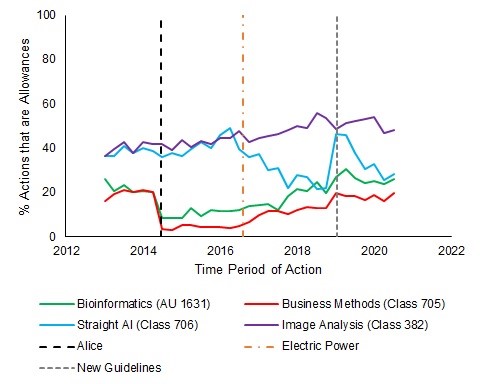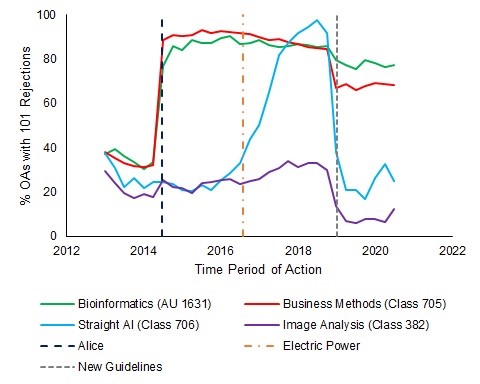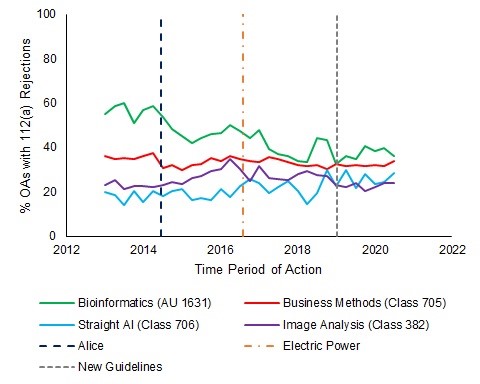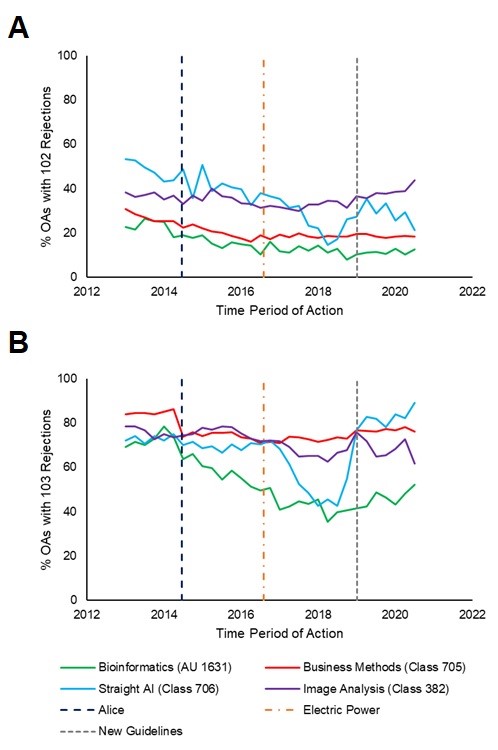The chances of securing an allowance to protect AI innovations vary dramatically across art units and time periods. Interestingly – for the first time since Alice – one recent allowance drop seems to be divorced from eligibility-rejection prevalence.
 As computing power and large datasets become more available, the use of artificial intelligence (AI) in technology is exploding around the world. As an indicator of the impact of AI, private equity investment in AI start-ups attracted 12% of worldwide private equity investments in the first half of 2018, reflecting a four-fold increase from just 3% in 2011, across all major economies. In the United States, the U.S. Patent and Trademark Office (USPTO) has taken steps to adapt to AI inventions, asking in August of 2019 for public comment on questions ranging from AI inventorship to how to best consider AI elements of inventions. The World Intellectual Property Organization (WIPO) has also asked similar questions, as part of its conversation on intellectual property (IP) and AI, which published its first Draft Issues Paper on IP policy and AI in December of 2019 and is continuing to hold meetings on the topic.
As computing power and large datasets become more available, the use of artificial intelligence (AI) in technology is exploding around the world. As an indicator of the impact of AI, private equity investment in AI start-ups attracted 12% of worldwide private equity investments in the first half of 2018, reflecting a four-fold increase from just 3% in 2011, across all major economies. In the United States, the U.S. Patent and Trademark Office (USPTO) has taken steps to adapt to AI inventions, asking in August of 2019 for public comment on questions ranging from AI inventorship to how to best consider AI elements of inventions. The World Intellectual Property Organization (WIPO) has also asked similar questions, as part of its conversation on intellectual property (IP) and AI, which published its first Draft Issues Paper on IP policy and AI in December of 2019 and is continuing to hold meetings on the topic.
An Expansive Definition
Artificial intelligence is a term that applies to various types of computers operating in a manner that mimics human intelligence. It includes rules-based approaches and machine-learning techniques. AI innovations may include new types of AI techniques (e.g., new neural network designs) or new applications of existing AI techniques (e.g., identifying particular data feeds, training, pre-processing, post-processing, etc.) that may avail AI to new problems. Because AI is quite a broad term, AI technology can be found in almost every industry. Some feel that all innovations in select fields (e.g., natural language processing, autonomous driving, image processing, machine translation, bioinfomatics and computer animation) qualify as AI innovations.
Given this diversity among technologies that qualify as “AI innovations”, does it make sense that the USPTO, WIPO and many stakeholders still organize discussions focused on this area? Or, is the topic too broad to provide for coherent and substantive discussion? To explore these issues, we tracked examination statistics for each of three types of AI innovations to determine how homogeneous the field is, at least with respect to patenting prospects at the USPTO.
The Data
Examination statistics were collected (from LexisNexis® PatentAdvisorSM) for each of the following AI fields: AI techniques (class 706), bioinformatics (art unit 1631), and image analysis (class 382). Examinations statistics for business methods (class 705) were also collected for comparison purposes. Examination statistics included, for each of multiple time periods: a number of allowances issued, a number of office actions issued, and a number of office actions issued that included a patent-eligibility rejection.
To monitor the extent to which examiners in particular areas during particular time periods were likely to allow a patent application, we tracked the percentage of actions that were allowances (as opposed to office actions). This statistic had the benefit of being quite independent from applicants’ decisions as to whether to abandon an application (as it may take many months to years for applicants to react to sharp declines in allowance prospects with abandonment, if they do at all). This statistic is generally lower than the traditional allowance rates, as most allowances follow multiple office actions.
Figure 1 shows the time series for the percentage of actions that were allowances for each of the AI class (blue line), bioinformatics art unit (green line) and image-analysis class (purple line). The bioinformatics allowances experienced a sharp drop following the Alice v. CLS Bank decision in 2014 (which mirrored a similar post-Alice drop in the business-method class, shown in the red line). Neither of the other AI classes experienced this drop. However, allowance prospects in the AI class did substantially drop following the Electric Power Group Federal-Circuit decision of 2016. Meanwhile, allowance prospects of the image-analysis class have remained quite steady (or potentially modestly increasing) over the last eight years.

Figure 1
The vast majority of the above-noted allowance shifts appear to be attributable to changes in the prevalence of eligibility rejections, which may – for a given technology area – change in response to new court cases that pertain to similar technologies. For example, the Electric Power Group decision may have triggered training and/or guidance provided to examiners in class 706.
Figure 2 shows the percentage of office actions that included an eligibility rejection. Notably, the post-Alice dips in bioinformatics and business methods and the post-Electric Power Group dip in the AI class coincide with increased prevalence in eligibility rejections.

Figure 2
There is one discrepancy to this potential anti-correlation. In early 2019, allowances in the AI class jumped (following new USPTO guidance pertaining to patent eligibility) and then began to slowly and substantially decline. While the initial allowance jump was accompanied by a fall in eligibility rejection, the subsequent allowance decline (in 2019 and early 2020) was not accompanied by an increase in eligibility rejections.
So, if not for the eligibility requirement, why were more AI applications being rejected? Potentially, more disclosure-related rejections were being issued. Machine-learning results can depend greatly on training data, hyperparameter selection, pre-processing, techniques, etc. Thus, it would be conceivable that the USPTO began to require more detail in this respect to fulfill the enablement or written-description requirements. To investigate this possibility, we tracked the percentage of office actions that included a 112(a) rejection (Figure 3). A modest increase in 112(a) rejections were observed in the AI class. However, the trend did not track the magnitude or temporal shifts of the recent allowance-rate decrease for this class.

Figure 3
We therefore further investigated the percentage of office actions that included an anticipation (Figure 3A) or obviousness (Figure 3B) rejection. The percentage of office actions issued in the AI class that included an anticipation rejection since the new USPTO guidance has been decreasing, while the prevalence of obviousness rejections has been steadily increasing. Potentially, the increased obviousness rejections may at least partly explain the recent allowance drop, or potentially examiners are issuing more obviousness rejections in lieu of anticipation rejections. In the latter case, the decreased allowances may be explained by (for example) examiners maintaining rejections for a longer time or issuing more serial rejections (e.g., with different art citations).

Figure 4
Impossible to Predict
Our data for the years between 2013-2020 show that the prospects of patenting an AI innovation varies dramatically across art units. Similar variation is seen in data showing the likelihood of receiving a particular type of rejection (e.g., an eligibility rejection). AI is an incredibly large and diverse field, so some statistical variation in rejection prevalence across art units may make sense. For example, certain AI technologies may be popular in a field during a given period of time, leading to more prior art being available relative to other types of AI technologies. As another examples, particular AI innovations may be more clearly tied to a practical application that may indicate that the claims are patent eligible.
That being said, the examining division appears to have a sizeable influence on prosecution outcome. For this reason, we suspect that some of the variation is due to differences in training and cultures across art units. For example, as noted, image-processing applications are unlikely to receive eligibility rejections, which is perhaps due to a “practical application” tied to the claimed invention. However, would this same logic not apply to bioinformatics inventions? Why, then, in Q2 2020, would 77% of office actions issued by the bioinformatics art unit (AU 1631) include an eligibility rejection, whereas only 12% of the office actions issued by the image-analysis class (Class 382) including an eligibility rejection?
Returning to the question at hand: What’s the likelihood that an AI patent application will be allowed at the USPTO? The high variability across time periods and art units that we observed in both allowances and rejections defies a direct link between inclusion of AI technology and a given outcome at the USPTO. For this reason, it is impossible to predict the likelihood of an AI patent application being allowed at the USPTO. Prudent applicants and practitioners would thus be well-advised to track both high-level data and data pertaining to particular examiners.
Image Source: Deposit Photos
Vector ID:144566865
Copyright:studiostoks

![[IPWatchdog Logo]](https://ipwatchdog.com/wp-content/themes/IPWatchdog%20-%202023/assets/images/temp/logo-small@2x.png)


![[Advertisement]](https://ipwatchdog.com/wp-content/uploads/2024/04/Patent-Litigation-Masters-2024-sidebar-early-bird-ends-Apr-21-last-chance-700x500-1.jpg)

![[Advertisement]](https://ipwatchdog.com/wp-content/uploads/2021/12/WEBINAR-336-x-280-px.png)
![[Advertisement]](https://ipwatchdog.com/wp-content/uploads/2021/12/2021-Patent-Practice-on-Demand-recorded-Feb-2021-336-x-280.jpg)
![[Advertisement]](https://ipwatchdog.com/wp-content/uploads/2021/12/Ad-4-The-Invent-Patent-System™.png)







Join the Discussion
7 comments so far.
George
January 14, 2021 08:37 pmWhy can’t we create a FanDuel or DraftKings for patents? Would be great!!! (Lawyers, judges and patent employees would be prohibited from participation, due to the clear conflict of interest that would arise).
People could bet on who might or might not get a patent and whether or not it will be upheld in the PTAB, or the courts, and whether or not it will be infringed, or not a patent could win an infringement suit (or even if an inventor could afford to battle it out – i.e. go all ‘8 rounds’). Each bet would have worse and worse odds, starting at maybe 30% and going down to 0.1%. A bet of $1000 could then make you a million!!! The states would have to approve it of course, but for a 10% ‘rake’ they probably would! Why not??? More money in their coffers! Would also help promote IP and inventors and get the public to ‘study’ all about IP and IP legal cases!!! They would get interested because it could really pay off for them, even if they’re not inventors! In fact, they likely would make more money that way, than they would as inventors!!! Would get inventors lots of attention and publicity at the same time too, with some even becoming favorites & invention ‘heroes’!
That might even discourage infringers from wanting to get all that public attention and the public betting – against them!
What’s not to like about the idea?! Would make our patent system an ‘official & legal’ lottery – rather than the illegal one it is now!
Copyright, January 14, 2021 (LOL)
George
November 12, 2020 12:07 pmMight as well relocate the USPTO to Vegas now and allow ‘betting’ on who will get a patent & who won’t (could be very lucrative)!!! Could become a very popular new addition to other forms of ‘gambling’! But, I wonder what the Founders would think about this and if that’s what they had in mind when writing Article I, Section 8?! Kinda doubt it!!!
George
October 26, 2020 11:31 pmValuable insights (to join others we’ve gathered).
George
October 26, 2020 10:59 pmThank you! I think the above questions at least deserve some serious discussion among attorneys (especially those knowledgeable about state gaming laws and what happened in FanDuel & DraftKings). What is the difference here? I really would like to know (before I file suit against the PTO in my home state, and invite others to do the same).
George
October 26, 2020 04:45 pmHint #3: Anyone remember ‘FanDuel’ & ‘DraftKings’? Is the PTO really now just a ‘PatentKings’, wrapped in a clever and ‘pompous’ disguise? What would state courts say about it and how it operates?
George
October 26, 2020 04:41 pmHint #2: Any ‘gaming law’ experts out there? Anyone know the difference between ‘games of skill’ and ‘games of chance’ and how they are treated under various state laws and constitutions?
George
October 26, 2020 04:34 pmSo, it’s basically mostly ‘luck’ then, right? Not an objective, reproducible and consistent decision making process, right? Highly dependent on which art group & examiner you are ‘lucky’ to get, right? Some are easy and some are hard, right?! Luck of the draw, eh?!
. . . What does that imply counselors? Anyone care to guess?
Hint: Would this method of selecting who gets ‘awarded’ a ‘valuable patent’ and ‘who doesn’t’, be considered legal in any of the 50 states? Would it even be ‘constitutional’ in a few of those states?